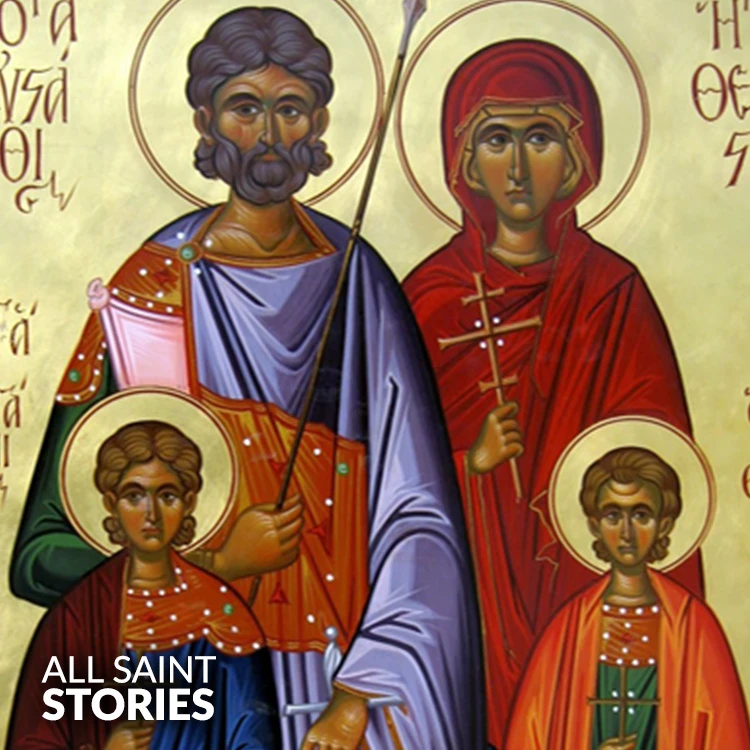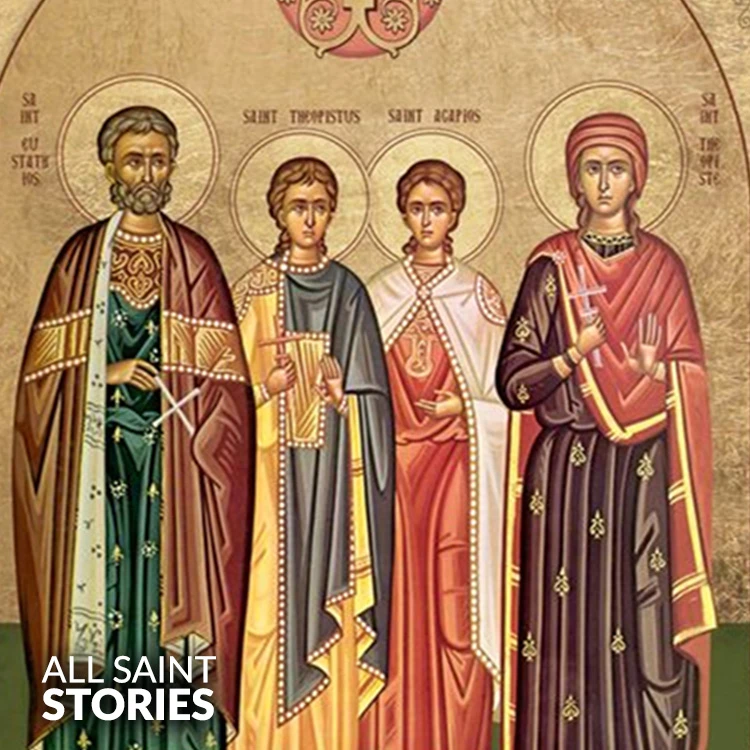O Glorious St. Eustachius, steadfast in your faith through trials and suffering, guide us to remain true to Christ in times of hardship. May your witness of love, endurance, and family devotion inspire us to live faithfully, courageously, and humbly. Amen.
ST. EUSTACHIUS AND HIS FAMILY
ST. EUSTACHIUS AND HIS FAMILY

St. Eustachius, originally a Roman general named Placidus, converted to Christianity after a miraculous vision of a crucifix between a stag’s antlers. Alongside his wife and sons, he endured separation, trials, and ultimately martyrdom for his faith under Emperor Hadrian.
St. Eustachius, known in his early life as Placidus, was a Roman general serving under Emperor Trajan in the late first and early second century AD. A man of strength and honor in Roman society, he experienced a profound religious transformation during a hunting expedition when he saw a vision of a crucifix between the antlers of a stag. This event marked his conversion to Christianity, and soon after, he and his entire household — including his wife Theopista and two sons — were baptized, with Placidus taking the name Eustachius.
After their conversion, their lives changed dramatically. They lost their wealth and status and suffered a series of misfortunes that would test their faith to its limits. While traveling, the family was separated. In the most well-known version of the legend, his wife was taken by a sea captain, and his sons were carried away by a lion and a wolf, though later miraculously reunited. Eustachius continued to serve Rome faithfully, even after losing his position and fortune.
Eventually, he was restored to his military command and served once again with distinction. However, when Emperor Hadrian ascended the throne, he required all officers to participate in a pagan ritual sacrifice. Eustachius, refusing to deny Christ, was arrested along with his wife and sons. They were offered the opportunity to recant, but their steadfastness remained unshaken. For their refusal, they were subjected to a particularly cruel martyrdom: being roasted alive inside a bronze bull, a symbol of imperial punishment meant to serve as a public warning.
Despite the horrific nature of their deaths, the story of St. Eustachius and his family endured and spread throughout Christendom. They became symbols of faith under trial, the sanctity of family unity in belief, and the courage to uphold Christian values in the face of persecution.
His legend shares similarities with that of St. Hubert, another saint who saw a crucifix in a stag’s antlers, leading to speculation that the two stories might have shared origins or inspired one another. Over time, Eustachius was adopted as the patron saint of hunters and firefighters, and his image often appears in religious artwork, especially in the Middle Ages.
Although there is limited historical documentation, and some scholars regard the legend as apocryphal or symbolic, St. Eustachius continues to be venerated in both Eastern and Western Christianity. His life represents the archetype of the noble convert who chooses divine truth over worldly honor, and the ultimate sacrifice of life in witness to that truth.
Video Not Found
The information on this website is compiled from various trusted sources. While we aim for accuracy, some details may be incomplete or contain discrepancies.
If you notice any errors or have additional information about this saint, please use the form on the left to share your suggestions. Your input helps us improve and maintain reliable content for everyone.
All submissions are reviewed carefully, and your personal details will remain confidential. Thank you for contributing to the accuracy and value of this resource.
Credits & Acknowledgments
- Anudina Visudhar (Malayalam) – Life of Saints for Everyday
by Msgr. Thomas Moothedan, M.A., D.D. - Saint Companions for Each Day
by A. J. M. Mausolfe & J. K. Mausolfe - US Catholic (Faith in Real Life) – Informational articles
- Wikipedia – General reference content and images
- Anastpaul.com – Saint images and reflections
- Pravachaka Sabdam (Malayalam) – Saint-related content and insights
We sincerely thank these authors and platforms for their valuable contributions. If we have unintentionally missed any attribution, please notify us, and we will make the correction promptly.
If you have any suggestion about ST. EUSTACHIUS AND HIS FAMILY
Your suggestion will help improve the information about this saint. Your details will not be disclosed anywhere.
© 2025 Copyright @ www.allsaintstories.com


 English
English
 Italian
Italian
 French
French
 Spanish
Spanish
 Malayalam
Malayalam
 Russian
Russian
 Korean
Korean
 Sinhala
Sinhala
 Japanese
Japanese
 Arabic
Arabic
 Portuguese
Portuguese
 Bantu
Bantu
 Greek
Greek
 German
German
 Dutch
Dutch
 Filipino
Filipino